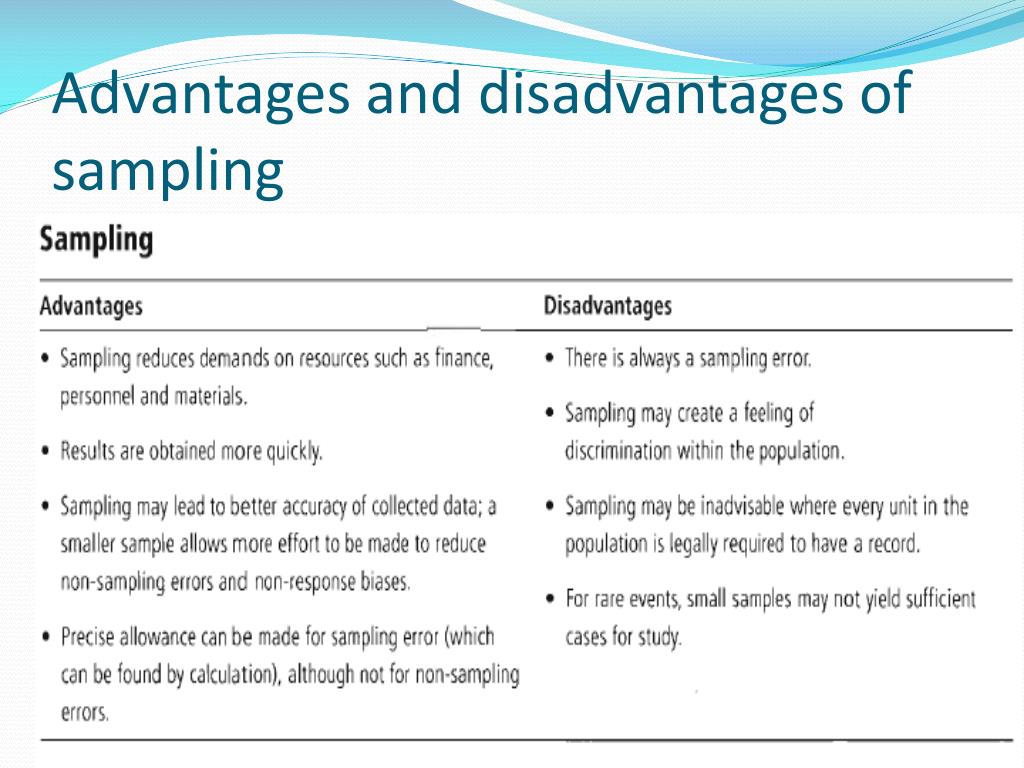Cluster Random Sampling Advantages And Disadvantages | The goal of random sampling is simple. A random sample of these groups is then selected to represent a specific population. In the above figure, we first assigned the random numbers to each of the elements and marked the elements with highest assigned number among the elements in the same group (or row). Advantages and disadvantages of probability sampling: Clustering leading to areas unsampled.
This method's greatest advantage is operational: Selecting a cluster to study is typically easier and more affordable than creating a random or systematic the chief disadvantage of using cluster sampling is the notable risk that the clusters may not be truly homogeneous among each other. Advantages and disadvantages of cluster random sampling pdf download >>> bit.ly/2e4m7as. Stratified sampling offers several advantages over simple random sampling. A random sample of these groups is then selected to represent a specific population.

In the above figure, we first assigned the random numbers to each of the elements and marked the elements with highest assigned number among the elements in the same group (or row). Advantages and disadvantages of srs. Covers proportionate and disproportionate sampling. Advantages of cluster sampling : When the population consists of units rather than individuals. Giving every member of the. Contents toggle main menu 1 sampling 2 random sampling2.1 advantages2.2 disadvantages 3 stratified sampling3.1 advantages3.2 disadvantages 4 worked example 5 cluster sampling5.1 advantages5.2 disadvantages 6 systematic sampling6.1 advantages6.2 disadvantages 7. Simple random sampling addresses the issue by avoiding the consecutive data to occur simultaneously. Describes stratified random sampling as sampling method. Advantages and disadvantages of cluster random sampling pdf download >>> bit.ly/2e4m7as. To overcome this problem you can choose a random clustered key for your clustered index, because then you are distributing the inserted records across multiple different places in the. Here are some of the additional advantages and disadvantages of random sampling that worth considering. The goal of random sampling is simple.
The four basic random sampling techniques are simple random sampling, stratified random sampling, systematic random sampling, and cluster (or area) random sampling. Each technique offers advantages and disadvantages. Cluster sample may combine the advantages of both random sampling as well as stratified sampling. These are the advantages and disadvantages of simple random sampling you will want to consider when looking at the subjects. Sampling technique used when natural but relatively homogeneous groupings are evident in a statistical population.

Advantages and disadvantages of cluster random sampling pdf download >>> bit.ly/2e4m7as. Selecting a cluster to study is typically easier and more affordable than creating a random or systematic the chief disadvantage of using cluster sampling is the notable risk that the clusters may not be truly homogeneous among each other. In the above figure, we first assigned the random numbers to each of the elements and marked the elements with highest assigned number among the elements in the same group (or row). Obtain a simple random sample of so many clusters from all possible clusters. Lists pros and cons versus simple random sampling. March 29, 2016 · klaus aschenbrenner · 2 comments. Covers proportionate and disproportionate sampling. Clustering leading to areas unsampled. Obtain data on every sampling unit in each of the randomly selected clusters. This becomes difficult when the population size cannot be it can even help in the elimination of cluster selection. Simple random sampling means that every member of the population has an equal chance of being included in the usefulness of simple random sampling with small populations is actually a disadvantage with big populations. Explanation about this sampling with example, it's advantages and disadvantages are discussed here. Describes stratified random sampling as sampling method.
Covers proportionate and disproportionate sampling. Explanation about this sampling with example, it's advantages and disadvantages are discussed here. With cluster sampling, one should. Here are some of the additional advantages and disadvantages of random sampling that worth considering. While the randomness of the selection process ensures the unbiased choice of subjects, it could also, by.

Since it is done at random, the whole process is unbiased. The four basic random sampling techniques are simple random sampling, stratified random sampling, systematic random sampling, and cluster (or area) random sampling. Advantages and disadvantages of srs. Stratified sampling offers several advantages over simple random sampling. These are the advantages and disadvantages of simple random sampling you will want to consider when looking at the subjects. No personal selection or judgement. To overcome this problem you can choose a random clustered key for your clustered index, because then you are distributing the inserted records across multiple different places in the. Sampling & its types | simple random, convenience, systematic, cluster, stratified. Sampling technique used when natural but relatively homogeneous groupings are evident in a statistical population. Cluster sampling is a sampling method where populations are placed into separate groups. Here are some of the additional advantages and disadvantages of random sampling that worth considering. Divide the population into groups (clusters). Simple random sampling means that every member of the population has an equal chance of being included in the usefulness of simple random sampling with small populations is actually a disadvantage with big populations.
Giving every member of the random sampling advantages and disadvantages. Obtain a simple random sample of so many clusters from all possible clusters.
Cluster Random Sampling Advantages And Disadvantages: Advantages and disadvantages of sampling techniques.
Posting Komentar